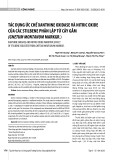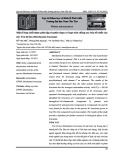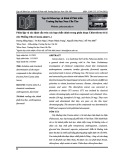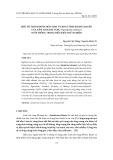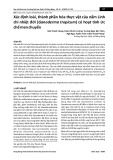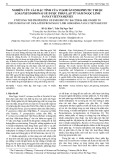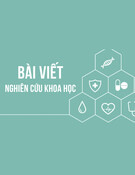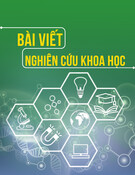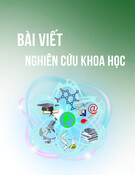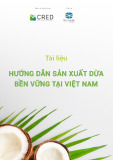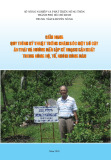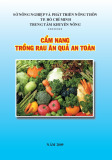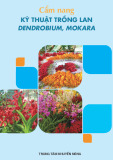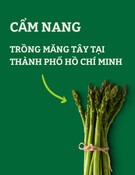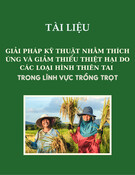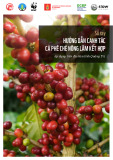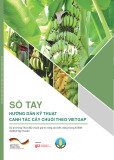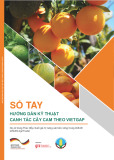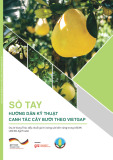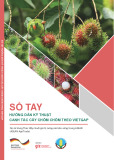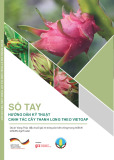
Tập 18 Số 5-2024, Tạp chí Khoa học Tây Nguyên
11
PHYTOCHEMICAL PROFILES AND POTENTIAL BIOLOGICAL ACTIVITIES OF
THE FLOWER EXTRACT OF Santalum album L. GROWN IN DAKLAK PROVINCE
Phan Thi Kim Phung1, Tran Thi Minh Tam1, Nguyen Thi Hong1, Le Thi Thu Hong2,
Nguyen Duc Dinh3, Ho Thi Thanh Thanh4, Doan Manh Dung5
Received Date: 23/08/2024; Revised Date: 10/10/2024; Accepted for Publication: 11/10/2024
ABSTRACT
This study explores phytochemical profiles and several biological activities of Santalum album L.
flowers collected from Dak Lak Province, Vietnam. The qualitative phytochemical analysis of Santalum
album flower extracts reveals the presence of free triterpenoids, flavonoids, and tannins, particularly in
the alcohol and water extracts, suggesting a rich source of bioactive compounds with potential therapeutic
benefits, while other compound groups like saponins, alkaloids, coumarins, and essential oils are either
absent or present in very low concentrations. Through UHPLC methods, a range of bioactive compounds
were identified, including 10 flavonoids and 2 polyphenols compounds. Main compounds identified
include salicylic acid, vitexin and catechin. The antioxidant potential of the extracts was evaluated using
DPPH and ABTS radical scavenging assays with IC50 values of 152.08 ± 0.11 µg/mL and 104.32 ± 0.19
µg/mL, respectively, showing significant free radical inhibition. Additionally, the extracts demonstrated
inhibitory activity against α-glucosidase and α-amylase with IC50 value of 233.05 ± 0.32 µg/mL and
124.27 ± 0.17 µg/mL respectively. These findings suggest the potential of the Santalum album L. flower
extract in managing diabetes, particularly with its weaker inhibition of α-amylase compared to acarbose,
which may help minimize side effects commonly associated with synthetic drugs. This research
represents the first comprehensive phytochemical investigation of Santalum album flowers, revealing a
rich chemical profile that supports further exploration into their pharmacological applications.
Keywords: Santalum album L., flower extract, phytochemistry, flavonoid, anti-diabetes.
1. INTRODUCTION
Santalum album L., commonly known as
sandalwood, is a species renowned for its fragrant
heartwood, traditionally used in perfumery,
cosmetics, and religious rituals (Sharma and
Kaushal, 2021). Beyond its aromatic properties,
Santalum album has been the subject of various
studies due to its rich phytochemical profile,
which includes flavonoids, sesquiterpenes,
tannins, fatty acids, esters, aldehydes,
vitamin, and minerals (Bisht and Kumar,
2021). These compounds are associated with
diverse pharmacological activities, such as
antioxidant, anti-inflammatory, anti-cancer,
anti-diabetic anti-viral, anti-bacterial, anti-
fungal, hepatoprotective and cardio-protective
properties (Sharma and Kaushal, 2021). The
successful cultivation of Santalum album in Dak
Lak Province has not only provided a valuable
source of herbal medicine but also holds
significant economic importance.
Despite the well-documented benefits of
Santalum album, its flowers have received
comparatively less attention. Phytochemical
investigations into other plant flowers have
revealed a richness in bioactive compounds such
as flavonoids, tannins, and polyphenols, which
are known for their roles in combating oxidative
stress, managing diabetes, and preventing
neurodegenerative diseases such as Alzheimer’s.
For example, Hibiscus rosa-sinensis flowers
are known for their high content of bioactive
compounds, which exhibit significant antioxidant
and anti-inflammatory properties (Geeganage
and Gunathilaka, 2024). Similarly, Sophora
japonica flowers contain variety of bioactive
compounds, including flavonoids (kaempferol,
quercetin, rutin, isorhamnetin), isoflavonoids
(genistein, sophoricoside), triterpenes, alkaloids,
and polysaccharides. These compounds contribute
to a range of pharmacological actions, such
as cardiovascular benefits, anti-inflammatory,
antioxidant, antitumor, anti-diabetic effects (X. He
et al., 2016), (Ghatti et al., 2024).
1Faculty of Medicine and Pharmacy, Tay Nguyen University;
2Faculty of Pharmacy, Lac Hong University;
3Faculty of Agriculture and Forestry, Tay Nguyen University;
4Department of Science and Technology of DakLak Province;
5Institute of Biotechnology and Environment, Tay Nguyen University;
Corresponding author: Doan Manh Dung; Tel: 0912717202; Email: dmdung@ttn.edu.vn.

Tập 18 Số 5-2024, Tạp chí Khoa học Tây Nguyên
12
To address this gap, we employed Pressurized
Liquid Extraction (PLE) and Ultra-High
Performance Liquid Chromatography (UHPLC)
to extract and profile the bioactive compounds
from Santalum album flowers. PLE enhances the
efficiency of extracting secondary metabolites
from plants by reducing both solvent use and
extraction time, while UHPLC ensures high
resolution and sensitivity for detecting even low
concentrations of target molecules (Wianowska
and Gil, 2019), (Nováková and Vlčková,
2009). Additionally, antioxidant (DPPH and
ABTS assays) and anti-diabetic (α-amylase and
α-glucosidase inhibition) assays were employed
to evaluate the biological potential of the
extracts.
This research represents the first investigation
into the bioactive compounds present in Santalum
album L. flowers. Through UHPLC and bioactivity
assays, this study aim to identify the key
phytochemicals and explore their pharmacological
potential, particularly focusing on antioxidant and
anti-diabetic activities (Scheme 1).
Scheme 1. A scheme of the study: (A) Source of extract, (B) Extraction process, (C) Phytochemi-
cal profile and (D) Bioactivities
2. MATERIALS AND METHODS
2.1. Materials
Santalum album flowers were collected in
2024 from Dak Lak Province, Vietnam. The plant
was authenticated by Nguyen Duc Dinh. The
flowers were dried to a constant weight, vacuum-
sealed in polyethylene bags, and labeled SAL-
DL-2024 (Santalum album L.- Dak Lak - year
2024). These specimens were stored at 0-4 °C
until extraction.
Pharmaceutical-grade ethanol (Vietnam) was
used as the solvent for extraction.
The standards chemicals for UHPLC analysis,
including catechin, chlorogenic acid, epicatechin,
epicatechin gallate, vitexin, salicylic acid,
isovitexin, rutin, apigetrin, quercetin, luteolin,
kaempferol were procured from Sigma Chemical
Co., USA.
Enzymes α-glucosidase, α-amylase and
reagents 2-diphenyl-1-picrylhydrazyl (DPPH),
2,2’-azino-bis(3-ethylbenzothiazoline-6-sulfonic
acid) (ABTS) were purchased from Sigma
Chemical Co., USA.
2.2. Methods
2.2.1. Preparation of the extract from Santalum
album flower
The extraction of Santalum album flowers
was conducted using the pressurized liquid
extraction (PLE) technique, following a modified
method described by Phan Thi Kim Phung et al
(Phan Thi Kim Phung et al., 2023). The process
involved soaking 2 grams of dried flower powder
in 20 mL of 70% ethanol under pressure 100
bar, temperature extraction 60oC for 50 minutes
by PLE system E-916 (SpeedExtractor E-916,
Buchi, Switzerland). After that, the extract was
filtered, evaporated to remove the solvent, and the
concentrated extract was stored at a temperature
between 0-4°C for futher analysis.
2.2.2. Phytochemical analysis
Preliminary qualitative analysis: The
phytochemical composition of Santalum album
flowers was investigated using ether, alcohol,
and water extracts. These extracts were tested
for the presence of bioactive compounds such
as alkaloids, saponins, coumarins, anthranoids,

Tập 18 Số 5-2024, Tạp chí Khoa học Tây Nguyên
13
terpenoids, steroids, tannins, flavonoids,
carotenoids, and cardiac glycosides etc, using
standard phytochemical screening methods
(Shaikh and Patil, 2020), (Cyril et al., 2019).
Ultra High-Performance Liquid
Chromatography method: The components of
flavonoids and phenolics in the Santalum album
flower extract were analyzed using a UHPLC
system (Thermo Ultimate 3000, USA) based on
the method described by Doan Manh Dung et al
(Doan et al., 2023). The extract was prepared at a
concentration of 10.0 mg/mL in methanol (MeOH)
and filtered through a 0.45 µm Polyvinylidene
difluoride membrane filter before injection.
Separation was performed using a Hypersil GOLD
aQ column (3 µm, 150 × 2.1 mm) at 30°C. The
mobile phase consisted of MeOH and water with
0.10% H₃PO₄, with a flow rate of 0.2 mL/min. The
gradient elution program ranged from 5% to 95%
MeOH over 26 minutes, with peaks detected at
265 nm.
2.2.3. Bioactivity assays
For the evaluation of biological activities,
several assays were employed:
Antioxidant Activity: The DPPH and
ABTS radical scavenging assays were used
to assess antioxidant potential, following the
protocols detailed by Nguyen Quang Vinh et
al (Nguyen Van Bon et al., 2018). In brief,
samples at various concentrations were mixed
with DPPH or ABTS solutions, incubated, and
the absorbance was measured at 517 nm and
734 nm, respectively. Ascorbic acid served as
the positive control.
Anti-glucosidase and Anti-amylase Assays:
These assays were performed based on the method
described by Nguyen et al (Nguyen Van Bon and
Wang, 2018), using acarbose as a control.
All tests were conducted in triplicate. The
inhibitory activity was measured and presented as
percentage inhibition, with IC50 values calculated
to determine the concentration required to inhibit
50% of the enzyme activity. Lower IC50 values
indicate stronger inhibitory potential.
2.2.4. Statistical Analysis
Data were analyzed using Microsoft Excel
and SPSS software. The analysis involved the
calculation of means and standard deviations (SD)
to summarize the data. A p-value of <0.05 was
considered statistically significant.
3. RESULTS AND DISCUSSIONS
3.1. Chemical profiles of Santalum album flower
extract
3.1.1. Preliminary qualitative analysis
The qualitative phytochemical analysis of
Santalum album flower extracts is summarized
in Table 1. The results indicate the presence or
absence of various phytochemical groups across
different solvents used for extraction.
Table 1. Qualitative phytochemical analysis of Santalum album flower extracts
Test Reagent/Method
Qualitative Results
Ether
Extract
Alcohol
Extract
Water
Extract
Lipids Spot test -
Carotenoids H2SO4-
Essential Oils Evaporation to residue -
Free Triterpenoids Libermann-Burchard reagent +
Alkaloids General alkaloid reagent - - -
Courmarins Fluorescence in alkali - - -
Anthranoids 10% KOH -
Flavonoids Mg/HCl - ++ -
Cardiac Glycosides Lactone ring reagent - -
2-deoxy sugar reagent - -
Anthocyanosid HCl -
KOH -
Proanthocyanidin HCl/temperature -
Tanins Ferric Chloride +++ +++
Gelatin -+

Tập 18 Số 5-2024, Tạp chí Khoa học Tây Nguyên
14
Test Reagent/Method
Qualitative Results
Ether
Extract
Alcohol
Extract
Water
Extract
Saponins Saponin - -
Reducing Substances Fehling’s reagent - -
Note: (-) Not present, (±) Not clear, (+) Slightly present, (++) Present, (+++) Abundantly present,
(++++) Highly abundant
There may be a reaction, but it was not performed
The compound group is not present in the extract
The detection of free triterpenoids in the
ether extract of Santalum album flowers suggests
potential therapeutic applications related to these
compounds.
The Ferric Chloride test shows a strong
positive reaction (+++) in both alcohol and
water extracts, indicating a significant presence
of phenolic compounds. The presence of
flavonoids predominantly in the alcohol extract,
along with tannins in water extracts, highlights
the effectiveness of polar solvents in extracting
these bioactive compounds. Flavonoids, known
for their powerful antioxidant properties, have
potential roles in cancer prevention, diabetes
management, and anti-Alzheimer’s activities,
warranting further study (Nguyen Van Bon et al.,
2023), (Phan Thi Kim Phung et al., 2023)In this
research, the specific components of flavonoids
in Santalum album flowers will be analyzed using
the UHPLC method.
The absence of sapoin, alkaloids, coumarins,
and essential oils etc suggests they are either
not present or are in very low concentrations in
Santalum album flowers, which may help narrow
the focus of future studies.
This study adds valuable information to the
chemical profile of Santalum album, especially
since the phytochemical profiles of its flowers
have not been previously reported. The presence of
bioactive compounds highlights the potential for
further research to isolate and characterize these
compounds, as well as investigate their specific
bioactivities.
3.1.2. UHPLC Analysis
The qualitative phytochemical analysis
indicated that flavonoids were predominantly
present in the alcohol extract ofnSantalum
album flowers. To further investigate these
findings, UHPLC was conducted to determine
the flavonoid and phenolic components present
in the extract. The UHPLC analysis of Santalum
album flower extract revealed a profile of
phenolic compounds, with a significant presence
of flavonoids and polyphenols (shown in Table 2
and Figure 1).
Table 2. Content of major compounds identified from Santalum album flower extract
No Compound Group/Subgroup Content (mg/g) (n=3)
1Catechin Flavonoid/Flavanol 15.178 ± 0.013b
2Chlorogenic acid Polyphenol 9.117 ± 0.01d
3Epicatechin Flavonoid/Flavanol 7.014 ± 0.011e
4 Epicatechin gallate Flavonoid/Flavanol 5.832 ± 0.005f
5 Vitexin Flavonoid/Flavone 15.425 ± 0.004b
6 Salicylic acid Polyphenol 50.792 ± 0.023a
7Isovitexin Flavonoid/Flavone 11.512 ± 0.004c
8Rutin Flavonoid/Flavonol glycoside 4.371 ± 0.003g
9 Apigetrin Flavonoid/Flavonol glycoside 0.311 ± 0.001h
10 Quercetin Flavonoid/Flavonol 0.063 ± 0.002i
11 Luteolin Flavonoid/Flavone 0.06 ± 0.001i
12 Kaempferol Flavonoid/Flavonol 0.038 ± 0.001k
Values in the same column with the different letters are significantly different

Tập 18 Số 5-2024, Tạp chí Khoa học Tây Nguyên
15
A total of 12 (1-12) distinct compounds were
identified in the analysis. Among the polyphenols,
salicylic acid was the most concentrated, with a
content of 50.792 mg/g. Salicylic acid is widely
recognized for its anti-inflammatory and skin-
soothing effects, making it a valuable component
in both therapeutic and cosmetic applications
(Phan Thi Kim Phung et al., 2023). Chlorogenic
acid (9.118 µg/g), another polyphenol, is known
for its antioxidant, anti-inflammatory, and anti-
diabetic, anticardiovascular, antimutagenic and
anticancer effects. (Miao and Xiang, 2020). Its
significant presence reinforces the potential
health benefits of Santalum album extract,
especially in managing oxidative stress-related
conditions.
Vitexin (15.425 mg/g) and catechin (15.181
mg/g) were identified as the most abundant
flavonoids. Vitexin, a flavone, is known for its
antioxidant, anti-diabetic, anti-inflammatory, and
neuroprotective effects (M. He et al., 2016), while
catechin, a flavanol, is recognized for its strong
antioxidant properties and its role in cancer and
cardiovascular diseases (Ohishi et al., 2022).
The high concentration of these compounds
suggests that Santalum album flowers could have
potent health-promoting properties. The extract
also contains notable amounts of epicatechin
(7.013 mg/g), epicatechin gallate (5.831 mg/g),
and isovitexin (11,512 mg/g), all of which are
flavonoids with documented antioxidant, anti-
inflammatory, and potential cardioprotective
effects (M. He et al., 2016), (Phan Thi Kim Phung
et al., 2023). Minor constituents such as rutin,
apigetrin, quercetin, luteolin, and kaempferol
were also identified.
Overall, the UHPLC analysis reveals that
Santalum album flowers are a rich source of
bioactive phenolic compounds, particularly
flavonoids and polyphenols. The high
concentrations of vitexin, catechin, and salicylic
acid suggest that the extract could be utilized
for its antioxidant, anti-diabetic and potential
therapeutic properties. Further studies could
explore the specific biological activities of these
compounds to better understand their synergistic
effects and potential health benefits.
3.2. Novel medical effects of Santalum album
flower extract
The bioactivity analysis of Santalum
album flower extract was conducted to assess
its inhibitory effects on various biological
targets, including free radical scavenging
activities (DPPH and ABTS), and carbohydrate-
metabolizing enzymes (α-amylase and
α-glucosidase). The IC50 values for these
activities are presented in Table 3.
Figure 1. UHPLC finger printing of Santalum album’s flower extract.


